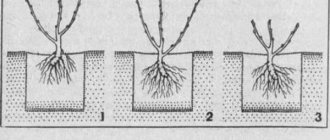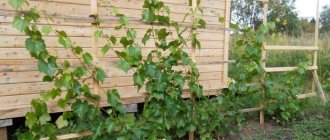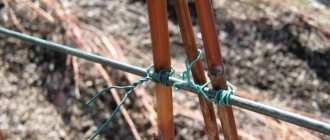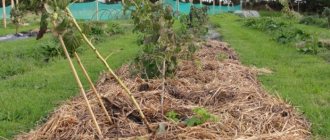- June 3, 2019
- Planting
- Michael
Probably every one of our compatriots knows and loves such a berry as raspberries. This is not surprising - these sweet, aromatic fruits will not disappoint even the most picky connoisseur. Of course, many garden owners try to grow bushes of this berry on their plots in order to get a rich harvest every season. However, it is not as simple as it seems. You need to know how to plant raspberries correctly and then care for them. Then you can be sure that the harvest will not disappoint!
The benefits of raspberries
Before giving step-by-step instructions on how to plant raspberries in summer or spring, it will be useful to briefly talk about the benefits of these berries.
Let's start with the fact that the fruits contain a large amount of vitamins - C and group B. They also contain fructose and manganese - a mineral important for human health, which is quite rarely found in berries, fruits and vegetables. These berries also contain coarse dietary fiber, which helps remove cholesterol and toxins from the body. Ketones, special substances, stimulate the breakdown of fat deposits, which is why raspberries are often prescribed to people suffering from excess weight.
Recent studies show that regular consumption of berries can slow down the growth of cancer cells, and in some cases even stops their growth in the early stages.
It has long been known that raspberries have a diaphoretic and anti-inflammatory effect on humans - it is no coincidence that our distant ancestors often used them in treatment.
Where to plant raspberries?
Now it’s time to figure out where to plant raspberries in the garden. After all, the speed of development, growth and productivity largely depend on the correct choice of a suitable location.
Raspberries, like most berry crops, are a perennial plant. Therefore, it will grow in one place for many years - it is very important to take seriously the choice of the most suitable site. After all, each transplant will be a serious stress for her.
It is advisable to choose sunny places, but it also grows well in partial shade, in areas that are illuminated only half a day per day. It is no coincidence that it is often located near fences. It is advisable to plant on the western side - then the raspberries will receive less light and heat in the morning, but more at noon and in the evening.
But cold winter winds can cause serious harm to raspberries, especially if they blow before enough snow falls - the bushes will simply freeze and not produce a harvest - they will need a whole year to recover from the roots. Therefore, if possible, you should choose an area protected from the wind. Again, the land near a fence or any buildings is suitable, be it a house, garage, bathhouse or something else. An additional plus is that the wind most often sweeps snow into such “nooks and crannies,” which means that raspberries will easily survive the winter and will delight you with a rich harvest in the summer.
Popular questions and answers: what else you need to know about the rules for choosing the distance between raspberry bushes
Growing in a greenhouse
Growing raspberries in a greenhouse is becoming increasingly popular and not only in cold regions. Remontant varieties bear fruit until October-December, which is impossible in the open air. In protected soil, all crops have common problems - lack of ventilation and sunlight. If the problem of photosynthesis can be solved by artificial supplementary lighting, then the ventilation of the bushes is regulated through thinning the plantings - the distance between the bushes should be at least 0.5...0.6 m .
Growing in pots
Growing raspberries in containers is a special case of the greenhouse method. If the weather worsens, the bushes are moved to a protected place (the same greenhouse) and wait for the harvest, regardless of weather conditions. It is advisable to maintain the optimal distance, which depends on the foliage of the bushes - nearby bushes should not touch the foliage.
Preparing the site
When you have decided where exactly you will grow this valuable crop, you need to deal with the next point - preparing the soil for planting raspberries.
If you plan to grow raspberries in an area where nothing has grown before, then no special soil preparation is needed - it is already rich in nutrients. Alas, this is extremely rare in small summer cottages and vegetable gardens. Depleted soil must be fertilized. Per square meter you need to spend 3-10 kilograms of manure or compost (depending on the type of soil and its depletion), 30-40 grams of potassium sulfate and 20-40 grams of superphosphate. What happens next depends on the time of planting the raspberries. For example, if you plan to plant it in the fall, then it is enough to scatter fertilizers around the area in the middle of summer - due to rains, they will gradually dissolve and seep into the soil, enriching it. But if you want to plant raspberries in the spring, then it is advisable to fertilize the soil in the fall or as soon as the soil warms up - in this case, the area will need to be dug up to speed up the process of absorption of fertilizers into the soil.
Preparation largely depends on the composition of the soil. For example, if you are working on sandy or clay soil, then it would be a good idea to increase the amount of manure - up to 15-30 kilograms, if possible. Manure will make clay soil lighter and poor sandy soil more nutritious. If you have to grow on peat soil, then it would be useful to sand - add up to 40 kilograms of sand per square meter, and then carefully dig up the top layer, mixing it with sand.
Post-landing work
After planting, raspberries must be watered generously: 1 bucket of water is taken for 5 seedlings. After moisture saturates the soil, the holes are sprinkled with dry soil. The bushes are not moistened if the weather is damp or there is prolonged rain. At other times, watering is repeated as needed.
To prevent crust formation, manure or humus is poured into the holes: approximately 3-4 kg of compost is taken for each of them. If it is available in sufficient quantities, then continuous strips 50-60 cm wide in rows are mulched with it.
In those regions where there is not enough precipitation, seedlings are mulched using an opaque film. To do this, it is divided into rows, the edges are buried in the ground and cut at the locations of the plantings. Old film material that has lost light transmission is also suitable as a mulch layer.
Mulching with an opaque film retains moisture in the soil well
If you follow the basic rules for planting raspberries, namely at what distance to plant raspberries from each other, choose healthy seedlings, prepare the soil correctly, this will allow you to get a bountiful harvest from year to year.
Planting raspberries
Now we’ll tell you how to plant raspberries correctly. This work is much more complex and responsible than it seems at first glance. To begin, choose the optimal raspberry planting scheme.
Some summer residents prefer a trench scheme, while others prefer single plantings. The first option is more convenient when collecting, but it is only suitable when there is a lot of free land. With it, the distance between the holes should be approximately one meter, and between the rows - up to two meters. The trench planting scheme for raspberries allows you to save useful space, although harvesting will be more difficult. In this case, a long trench or several are dug at intervals of about one meter. The distance between the bushes when planting raspberries is about 40 centimeters.
If the site is pure black soil, then additional fertilizer is not needed. But if you have to work with poorer soils, then it is advisable to fill the holes with a pre-prepared mixture - add 100 grams of granulated superphosphate, 400 grams of wood ash and 50 grams of potassium sulfate to 10 kilograms of humus or compost. A soft, light and nutritious mixture promotes a quick start - the bushes will develop at an amazing pace, which means the harvest will be very bountiful.
It is also very important to know how to plant raspberries correctly. The root collar should be located only a few centimeters higher than the soil level. Then, when the soil shrinks after several waterings, the plant will be in the most suitable conditions for growth. It is undesirable to overly bury the seedling - because of this, the root bud may begin to rot and the entire plant will die. But planting too high is a bad decision - raspberries will not be able to develop a powerful root system, which means they will not receive enough nutrients.
If the seedling is very long, then it is recommended to trim it so that the sprout rises about 30-40 centimeters above the ground. This will allow you to spend less moisture and nutrients on the development of the above-ground part of the plant, which means that the root system will grow more actively. In any case, you shouldn’t expect a harvest in the first year, but next year there will be much more berries, and the raspberries themselves will acquire stronger immunity.
Dependence of distance on place of growth
the geographical factor influences the choice of distance between seedlings - in different climatic zones of Russia, the same variety is planted taking into account local specifics with different intervals between seedlings.
Krasnodar region
Climate features - risk factors: hot, dry summers and winters with little snow;
Solution to the problem: thickening of plantings is encouraged, the distance can be reduced by 1/4 - up to 50 cm between bushes:
● in the summer, in the absence of irrigation, the soil will lose less moisture and overheat;
● in winter, thickening will help retain snow.
Moscow region
Climate features - risk factors: optimal conditions for growing raspberries;
Solution to the problem: given the frosts and snowy winters, it is necessary to plant bushes tied in a bunch, taking into account wintering.
Ural and Siberia
Climate features - risk factors: cold winters and strong frosty winds;
Solution to the problem: the free arrangement of bushes (distance up to 1 m) allows the wood to ripen faster and be better prepared for winter. Free-growing bushes are easier to bend to the ground in front of the shelter.
Seedling care
However, it is not enough to know how to plant raspberry seedlings. You also need to have an idea about caring for them in the first days after planting.
The most important thing is not to let it dry out. The root system of the bushes is very weak and they will not be able to get a lot of moisture from the soil. Therefore, you need to water them regularly, unless there is heavy rainfall.
Also, don’t forget about mulching. This is a really good solution. On the one hand, a thick layer of mulch successfully suffocates small weeds - they do not have time to break through it and simply die. On the other hand, mulch saves moisture. A strong wind dries out the top layer, while the soil remains moist, which means you won’t have to water the raspberry beds too often. Various raw materials can be used as mulch: sawdust, chopped dry grass, leaves, pine needles, manure. Gradually they will rot and nourish the soil with useful substances that stimulate the growth and development of plants.
In the first days after planting, some experienced gardeners even specially shade the raspberry bushes, protecting them from direct sunlight. This is also a good solution - being in the shade, plants lose less moisture, which allows them to develop more actively. After one or two weeks, the shading can be removed - by this time the bushes will have acquired a sufficiently developed root system to receive enough moisture from the ground.
How to care for raspberries in open ground after planting
Complete and regular care of raspberry seedlings after planting in spring or autumn is the key to successful establishment, normal plant growth and excellent fruiting. In no case should the basic stages of care be neglected; it is especially important in the first year of growing a plant. In addition, caring for the plant in open ground is very simple.
Immediately after the event, it is necessary to mulch the plant . The mulch layer is five centimeters. You can use sawdust, hay, humus, peat.
After planting, the raspberries (both remontant and regular) are pruned to a height of 20-25 centimeters. It is necessary to prune the seedling, because thanks to manipulation, survival will be faster and better, and it will also stimulate the growth of new shoots.
The most important element of care and cultivation is protecting raspberries before winter cold . To do this, at the first frost, you need to create a protective layer of peat around the seedling, a layer of about 15-20 centimeters, do not forget to remove the peat in the spring!
And if you live in regions where the plant may suffer from frost, for example, in Siberia, the Urals, the Middle Zone, the Volga region, then you also need to cover the seedling . To do this, you need to build a small frame around it, cover the frame first with agrofibre and then with polyethylene. In the spring, as soon as the first warm rays appear, you need to remove the shelter. But you should hurry with the shelter, because if you do it too early in the fall, the seedling may be destroyed.
If the planting was done in the spring, then you can put sheets of roofing felt between the rows , it will make it easier for you to control weeds.
If you applied the recommended fertilizers to the planting hole, then you should not fertilize in the first year ; the soil contains the necessary supply of nutrients.
A few words about watering
In general, raspberries do not need much water. Therefore, after the bushes take root and are able to receive enough moisture on their own, there is almost never any need to water it. At least if there are powerful torrential rains that deeply wet the ground at least once or twice a month. This makes raspberries an excellent crop for growing in dry regions.
But during the ripening of the berries (for some varieties this lasts for a couple of months - from the beginning of July to the end of August) you need to make sure that the bushes receive enough moisture. Otherwise, the berries will be very sweet, but small and inconspicuous. It is quite difficult to collect them, and they are not suitable for sale at all - hardly anyone will be interested in such meager creatures. Therefore, during the formation of berries, you need to water the raspberries at least once a week, if there is no regular rain. You also need to monitor the condition of the leaves. If they dry out and curl up, it means that the bushes need to be watered urgently. However, it is advisable not to let things get to this point - in dry conditions, raspberries may well drop their berries in order to reduce moisture loss, and leave the summer resident without a harvest.
Watering must be approached very seriously and responsibly. For example, you cannot use well water. Cold water will do more harm than good - penetrating to the roots of plants, it will overcool them, causing the plants to become seriously ill. Therefore, it is advisable to water it with rainwater (experienced summer residents specially collect it in barrels) or with well water, but it needs to be given a few days so that it warms up enough in the sun. Warm water will be much more beneficial than cold water.
Pros and cons of autumn planting
Planting raspberries in the fall has a number of advantages:
- autumn weather is preferable for this procedure;
- lower prices for planting material;
- the opportunity to evaluate the taste of berries of purchased varieties;
- lack of solar activity and sudden temperature changes.
Autumn raspberries do not waste energy on the formation of vegetative parts, which speeds up establishment and increases stability.
The weakness of autumn events is the inability to accurately predict the weather; for this reason, the risk of the first frost occurring before the end of the adaptation period is quite high.
Fertilizer
As mentioned above, raspberries are a perennial plant. It depletes the earth relatively little, but still needs regular feeding. Especially if you have chosen the trench method of planting raspberries, where the bushes are more crowded in a small area.
It is not necessary to use mineral fertilizers - you can get by with organic ones. This is a serious plus - many summer residents do not trust “chemical” fertilizers, which they also have to buy.
In the spring, it is advisable to feed raspberries with an infusion of bird droppings - quail, chicken, duck or any other. One kilogram of litter is diluted in ten liters of water and then left for a week. After this time, the solution is diluted with water in a ratio of 1:10 and the bushes are watered with the resulting fertilizer.
Green slurry also gives good results. A kilogram of grass (usually weeds) is filled with 10 liters of water - then follow the scheme described above.
In autumn, it is recommended to use a special complex infusion. A barrel or other suitable container is filled two to three full with a mixture of grass, hay, and tops. 200 grams of wood ash, a glass of vermicompost or manure, 300 grams of sugar or old jam, as well as two crayons (the usual ones they write in schools) are also added here. After this, the barrel is filled to the brim with warm water and left in the sun. Within ten days, the active fermentation process begins. After this time, you can use the mixture for fertilizer. When feeding, a liter of the mixture is diluted in a bucket of water, which is poured onto two or three raspberry bushes.
What depth is best to plant?
The depth of planting raspberries is 30-40 cm. Strong deepening of the roots will make it difficult for young shoots to germinate; shallow planting will lead to drying out and overheating of the root system. The diameter of the hole should be such that the roots, when straightened, are freely located in it.
Important! The root collar of the seedling should be at the level of the soil surface. If it is too deep, there is a risk of rotting, and if it is too high, the buds will dry out.
Regular pruning
Knowing how to plant raspberries correctly, you also need to have an idea about caring for them. An integral part of it is pruning. It should be carried out every year in the spring, before the buds swell and the active movement of juice begins.
Most often, excess stems are cut off right at the base - only one or two of the strongest, healthiest ones remain. Then the number of berries will be smaller, but their size will be much larger. Therefore, the volume of collected berries will remain almost unchanged, but the harvesting process will be significantly simplified. You can also trim the side shoots so that the bushes are even and do not turn into impenetrable thickets.
Don't forget about the garter
For more convenient harvesting, you should also tie up the raspberry bushes. To do this, the rows are simply fenced off on all sides so that they do not fall under their own weight - sometimes the stems are up to two meters long.
The procedure is quite simple and does not require annual updating. Metal rods or reinforcement are dug or driven in along the edges of the rows. At a height of about 120 centimeters, a wire is stretched - galvanized, stainless steel or aluminum. Thanks to this, the raspberries will always stand strictly vertically, and harvesting will be significantly simplified - you won’t have to lift each bush with one hand in order to pick the berries with the other.











